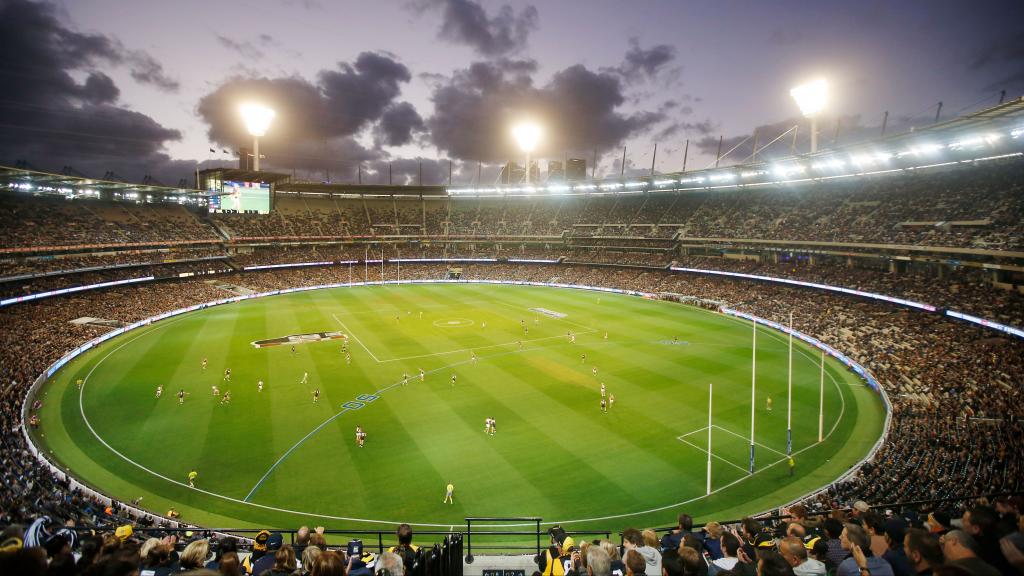PREMIERSHIP contender West Coast may finally have the cure to its giant MCG headache.
The Eagles have won just six of 24 matches at the home of football across the past decade, although one of those came this year over Carlton in round five – albeit somewhat unconvincingly.
Perth's Optus Stadium (165m v 130m) is similar in dimension to the MCG (160m v 141m), especially compared to the longer (175.6m) and skinnier (122.4) Subiaco.
An inspection of this year's game trends at Western Australia's new football venue and the MCG suggest there could be some benefits on rare trips east.
Playing on a wider ground allows players to practice the game style that will transfer to the MCG.
There are negligible differences in kicks (particularly long ones), uncontested possessions, contested marks, inside 50s, stoppage numbers, disposal efficiency, free kicks and scoring.
The main contrasts are teams tend to handball more often at the MCG – it was the opposite at Subiaco – and the kick-to-handball ratio is higher at Optus Stadium.
Throw in the more youthful and quicker nature of West Coast's list, minus the likes of retired Brownlow medallists Matt Priddis and Sam Mitchell, and it's almost a perfect storm.
Hard-running Jack Redden encapsulates the rebooted Eagles and is thriving playing on Optus Stadium, with his player rating more than two points better than at Subiaco the last two seasons.
Gameplay at the new Optus Stadium (top) is more similar to the MCG (middle) than West Coast's previous home at Subiaco (bottom). All pictures: AFL Photos

Former West Coast midfielder Xavier Ellis, who also played in Hawthorn's 2008 premiership, believes his old side could be a greater September threat because of the two developments.
"Playing on a wider ground allows players to practice the game style that will transfer to the MCG," Ellis told AFL.com.au.
"The Optus Stadium dimensions will help, but more so the (increased) ability of the players to cover the ground will make it much easier come their time on the MCG.
"As good a champions as Priddis and Mitchell were in the midfield, replacing their ageing legs with younger players and more leg speed has allowed West Coast to spread out and create more overlap and run and options through the corridor."
A comparison between Subiaco last year and Optus Stadium in 2018 illustrates it is easier to move the ball at the new venue.
Optus Stadium has similar dimensions to the MCG, a bonus for the Eagles. Picture: AFL Photos
The defensive 50 to inside 50 percentage at Optus Stadium is 20.7, compared to just 14.9 at Subiaco.
But as Ellis suggested, some of the numbers reflect player improvement and list demographics as much as ground characteristics.
Fremantle, for example, was one of the AFL's worst teams in ball movement last year, but has improved considerably in that area.
Optus Stadium's hard surface, which has repeatedly been linked to injuries, also promotes slicker ball movement, according to Ellis.
"The ground is rock hard and from my experience of playing on a hard ground it generally means the speed of the game goes up five, six, seven per cent," he said.
"You feel like you're running on the top of the ground and it's often hard to slow yourself down with the ball movement, because the ball's going to bounce up to you."
West Coast's only other match at the MCG before finals is a big test against Collingwood in round 17.
There is more to playing interstate than similar ground dimensions, but the Eagles might have found a way to somewhat bridge the gap.
Goalless periods on the rise
Overall scoring is at 50-year lows and that trend has carried over to another offensive statistic.
West Coast (first quarter), Melbourne (fourth) and Gold Coast (second and third) all went goalless in at least one term at the weekend.
That is nothing new in 2018, with 62 such barren quarters recorded in the first 14 rounds compared to only 29 at the same stage last year.
That number is the highest to this point of a season since there were 71 in 1966.
Demons lose the unloseable (again)
Melbourne seems to be doing so much right this year in the stats that matter, but ultimately only one truly matters – the scoreboard.
The Demons became the first team since Essendon eight years ago to lose despite having at least 25 more inside 50s (68-39) and 15 or more clearances (54-38) and contested possessions (177-158) than their opponent.
Port Adelaide toughed out a 10-point victory over Melbourne – and it wasn't the first time this season the Dees defied the odds in defeat.
They were just the 12th team to lose with 20 or more inside 50s out of 133 tries since 2015 against Geelong in round one.
The Demons also won inside 50s, clearances, contested possessions, tackles and hit-outs that day, earning the dishonour of being only the ninth side in 78 games to go down in that scenario.
Melbourne failed to convert its chances despite a massive inside-50 advantage. Picture: AFL Photos
Kangaroos love their Coleman Medal contender
No player comes close this year to being as central to his side's offensive fortunes as North Melbourne spearhead Ben Brown.
The Kangaroos target Brown with 38.8 per cent of their inside 50s, 10 per cent above the AFL's No.2 in the category, Crow Josh Jenkins.
West Coast's Josh Kennedy is actually targeted more times per game (12.2 to 11.7), but makes up only 26.4 per cent of the Eagles' entries.
The 2018 average for club leaders in this statistic is 26.8 per cent, while the highest recorded percentage across a season is Carlton's Brendan Fevola in 2009 (52.5 per cent).
The highest games for Brown this year are 82 per cent (round 10 vs Fremantle), 68 per cent (round four vs Carlton) and 47 per cent (round 14 vs Western Bulldogs) – all North wins.


